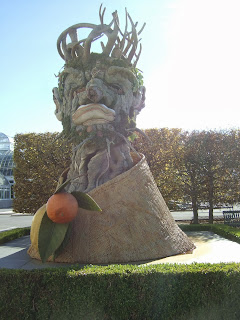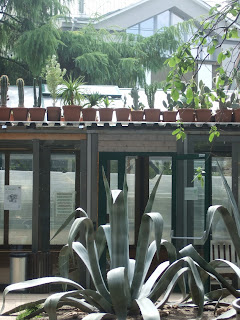Winter is an old man, indecifrabile, wrinkled, withered and gnarled, wrapped in a straw mat, eyes closed, lips sealed. He has the colours of an opaque trunk where shreds of moss cover the bark and branches of ivy are draped in the shaggy hair. He has a lemon and an orange .
'Winter' is a painting created by the Italian painter Giuseppe Arcimboldo (1527-1593) for Maximilian II in 1563, and a fifteen-foot-tall fiberglass scultpure created by Philipp Haas.
The paintings of the Four Seasons were created at the Court of the future Emperor of the Holy Roman Empire in Vienna, where Arcimboldo had moved from Milan in 1562. Political allegories of the House of Habsburg, encyclopaedic catalogues of plants, vegetables and flowers or scherzi (jokes) connected to popular traditions dating back to the Middle Ages, the paintings were on display in the Kunstkammer. In the art chamber, the curious Emperor amassed paintings, sculptures, coins, natural curiosities, rare and antique artefacts, precious objects. In the sixteenth century, these collections of curiosity explored and catalogued the natural and man-made world. They were the first step towards modern museums.
The four sculptures are currently on display at the New York Botanical Garden.
'Winter' is a painting created by the Italian painter Giuseppe Arcimboldo (1527-1593) for Maximilian II in 1563, and a fifteen-foot-tall fiberglass scultpure created by Philipp Haas.
The paintings of the Four Seasons were created at the Court of the future Emperor of the Holy Roman Empire in Vienna, where Arcimboldo had moved from Milan in 1562. Political allegories of the House of Habsburg, encyclopaedic catalogues of plants, vegetables and flowers or scherzi (jokes) connected to popular traditions dating back to the Middle Ages, the paintings were on display in the Kunstkammer. In the art chamber, the curious Emperor amassed paintings, sculptures, coins, natural curiosities, rare and antique artefacts, precious objects. In the sixteenth century, these collections of curiosity explored and catalogued the natural and man-made world. They were the first step towards modern museums.
The four sculptures are currently on display at the New York Botanical Garden.


Photos:
TravelinaGarden, The New York Botanical Garden, November 2013.
Painting: The Winter, 1563, oil on linden wood. Kunsthistorisches Museum, Vienna, Austria.
http://en.wikipedia.org/wiki/File:Arcimboldo_Winter_1563.jpg
Links:
Four Seasons, The New York Botanical Garden, 2900 Southern Blvd, Bronx, NY 10458
May 18, 2012 - March 30, 2014.
http://www.nybg.org/exhibitions/2013/four-seasons/index.php





